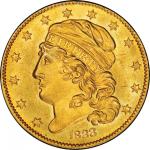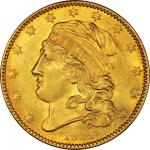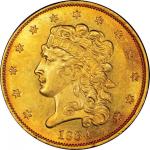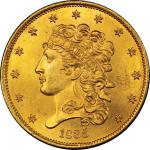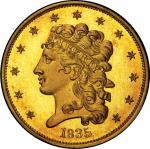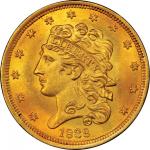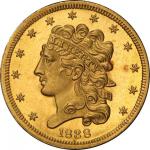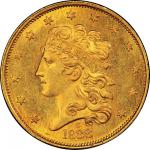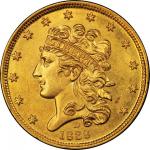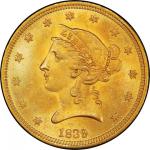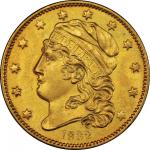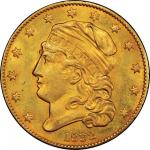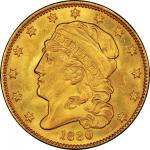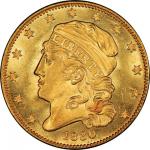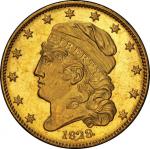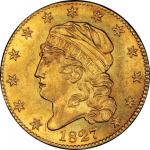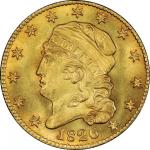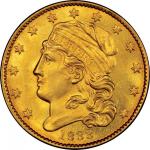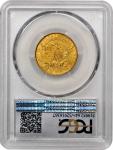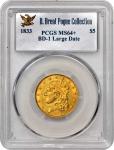Operations, I have now the satisfaction to say, have been commenced in the new Mint for the proof of the machinery; and all the departments of the institution will be transferred in a few days to that edifice.” — Mint Director Samuel Moore to President Andrew Jackson, January 15, 1833</em>Though struck from the same dies and exhibiting nearly the same level of preservation, this half eagle could not be more different in appearance from the Proof that precedes it. The surfaces are deeply frosty, displaying satiny luster that spins across the fields like a farm of windmills driven by the same breeze. Tinted with the precious light green often seen on United States gold coins of this vintage, the toning is an even light yellow, just a bit darker inside the obverse rim. The strike is good, with only modest softness in the usual central regions, and the fields are free of any significant impacts. Some light hairlines are seen on both sides, along with trivial abrasions and a few lines on Liberty’s cheek. A short thin scratch is noted between her throat and star 1. Artifacts of the phenomenon long termed “planchet chips,” likely caused by microscopic debris that clung to the die face at the moment of striking, is widespread around the obverse periphery, atop the date, and throughout the reverse fields, most concentrated above the denomination.If the Proof 1833 half eagle in the previous lot represents the earliest possible die state for this marriage, this coin occupies the nearly opposite end of the continuum. The obverse has cracked, from the right side of the lowest point of star 1, across the bust truncation to the bottom of the upright of the 1, and beyond to the rim below the space between 18. In a slightly later state, this crack continues to the rim on the other side of star 1. The reverse is also cracked, joining ITED at their bases and MER from the midpoint of M to the lower left serif of R. Die rust, produced by oxidation of the die surface rather than spalling, is seen all over the reverse, with pitting present on a band that crosses from between UN of UNITED, atop the upper leaf cluster, through the base of the shield, above the top arrowhead, and around R of AMERICA. Such impressive die rust is unusual on any individual United States Mint coin die, though it occasionally affected hubs or punches, as well as medal dies that were resurrected from a state of disrepair. This die, previously seen on 1832 half eagles in an unrusted state, shows enough rust here to suggest that more than a year may have elapsed before it was used in this 1833-dated combination. The rust seen on this coin is more advanced here than on the coin that follows, suggesting that 1833 BD-1 was actually coined after 1833 BD-2.Three and a half years after its cornerstone was laid on July 4, 1829, the second Philadelphia Mint was finally ready for occupancy in January 1833. The moving process took months, and May came before the Mint was completely operational. According to Roger Burdette’s<em> From Mint to Mint</em>, “the transfer of departments took place during late January and February,” but it appears that the first delivery of half eagles, given to the Treasurer of the Mint on March 30, were struck at the new Mint. Certainly all that followed that year, delivered on May 9, June 12 and 29, September 12 and 30, and December 31, were coined in the new structure. Philadelphia architect William Strickland designed the new structure with inspiration from the temples of ancient Greece, a departure from the 18th century brick structures that still dominated the Philadelphia skyline in 1829. Six Ionic columns stretched across the portico until the Mint was replaced by a larger facility in 1901. Though the second Philadelphia Mint is gone, the columns were saved when the building was demolished in 1902. In 2013, they were re-erected on the campus of Philadelphia’s Einstein Medical Center.While rare in any grade, the 1833 Large Date variety is particularly elusive in choice Mint State. The census of appearances, like the PCGS Population Report, is dominated by coins in AU and lower ranks of Mint State. Well worn 1833 half eagles are almost never seen, but gems are even rarer. PCGS has never certified an 1833 Large Date half eagle in MS-65 and assigned that grade to only one specimen of this date.PCGS# 8157. NGC ID: 25RJ.

